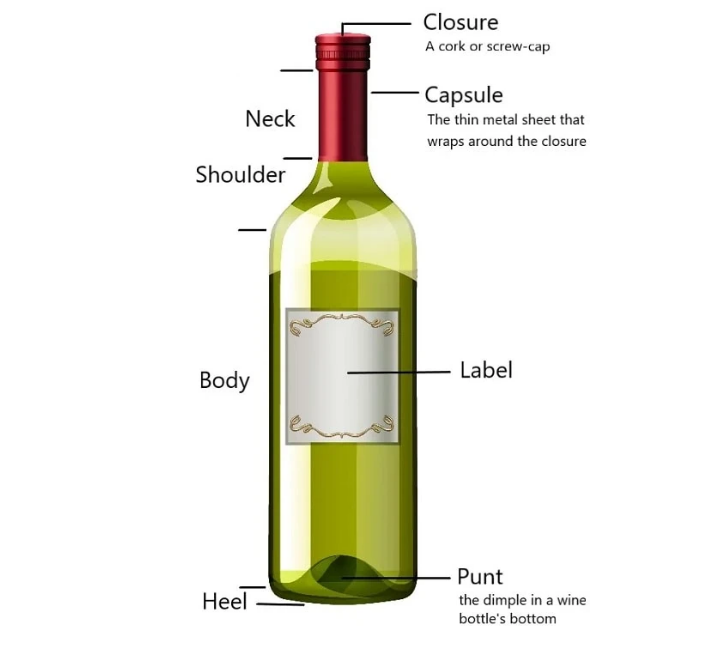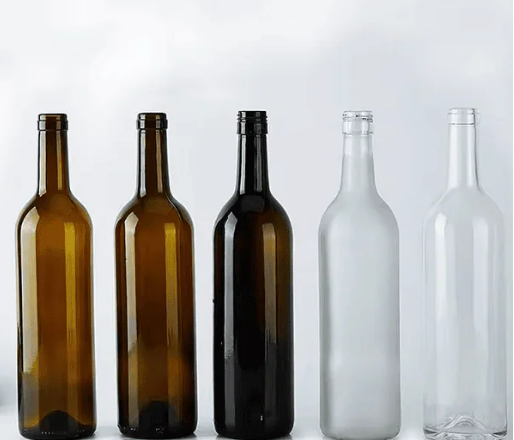Table Of contents
|
| 1.Closure |
| 2.Closure |
| 3.Neck |
| 4.Shoulder |
| 5.Body |
| 6.Label |
| 7.Heel |
| 8.Punt |
| 9.Conclusion |
Understanding the intricacies of wine bottle dimensions, components, and dimensions can be complex.Each wine bottle has a unique structure, with its components tailored to suit the specific characteristics of the wine it contains. Familiarity with these components not only enhances understanding, but also improves the art of pouring wine with precision and refinement.
Moreover, this knowledge is of great significance for those engaged in the wine industry or aspiring to be involved in winemaking. Collaborating with a reputable custom glass bottle manufacturer is crucial for ensuring the production of high-quality bottles that meet industry standards.
A wine bottle is composed of eight essential components, and each component has a different purpose. Below, you will find detailed information about each of these components.

Closure
The closure, be it a cork or a screw-cap, plays a crucial role in preserving the wine by thwarting air interaction. Factors such as oxygen permeability and the desired lifespan of the wine sway the choice between cork and screw-cap closures. Additionally, plastic wine bottle cap closures are on hand to seal the wine after opening, providing extra preservation perks.
Capsule
Enveloping the closure is the capsule, a thin metal sheath that safeguards the cork from drying out and stops the wine from evaporating. Beyond its preservative function, the capsule elevates the bottle’s aesthetic appeal and makes a contribution to hygiene standards.
Neck
The slender neck of the wine bottle offers a secure grip and ensures ease of handling. The level of wine in the neck serves as an indicator of the bottle’s integrity, with deviations suggesting potential cork problems or evaporation.
Shoulder
The sloping part just beneath the neck varies in shape and acts as a visual indicator of a bottle’s condition and storage history. Assessing the characteristics of the shoulder assists in evaluating wine quality.
Body
As the largest portion of the bottle, the cylindrical body contains the wine. Precise manufacturing guarantees efficiency in producing bottles with consistent quality and dimensions.
Label
Displaying essential wine particulars, labels adhere to regulatory norms while flaunting brand identity. Front labels typically showcase wine and brand specifics, while back labels incorporate origin and volume details.
Heel
Positioned at the bottom of the bottle, the heel offers stability and ensures the bottle remains upright. Different bottle shapes accommodate various wine types and storage requirements.
Punt
The dimple at the base of the bottle, referred to as the punt, bolsters structural integrity and assists in cooling the wine. Its depth can vary, providing design flexibility and serving as a stylistic element for sommeliers during pouring.
Conclusion
In conclusion, this article provides a detailed examination of wine bottle anatomy. With a variety of sizes and shapes, each bottle fulfills a specific purpose, mirroring the unique qualities of the wine it contains.
For those in search of a reliable glass container manufacturer, WXglass emerges as the top choice. Boasting over 26 years of industry know-how, WXglass offers customizable solutions crafted to meet individual requirements. Their dedication to quality workmanship and extensive global presence ensure unrivaled service.
Moreover, WXglass places a high priority on glass purity, ensuring containers that are suitable for both storage and decorative purposes. Glass remains the ideal material for producing outstanding wine bottles, combining practicality with aesthetic charm.
Contact us today to discover the perfect blend of functionality and style for yourpackaging needs.







